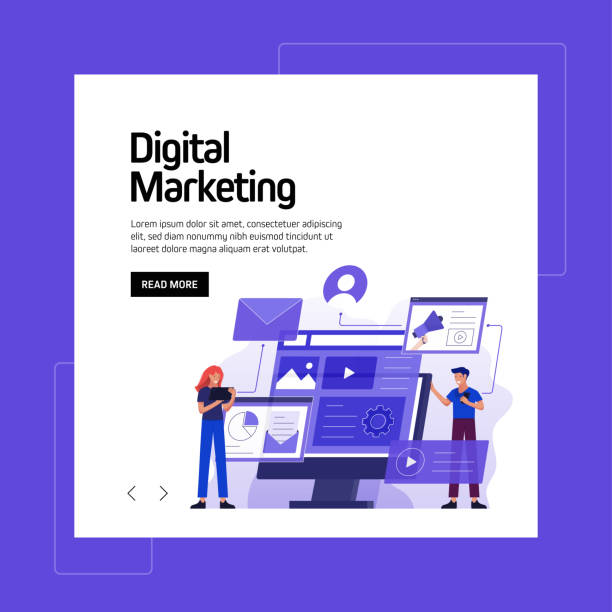An Introduction to Responsive Web Design and its Importance in the Digital Age

In today’s world, where technology advances at a dizzying pace, a digital presence is an undeniable necessity for businesses and individuals.
But this presence does not merely mean having a website; it means having a website that is displayed in the best possible way and provides a consistent user experience on every device, from small smartphones to tablets and large desktops.
This is where the concept of #Responsive_Web_Design comes into play.
#Responsive_Web_Design (RWD) is an approach that ensures the layout and content of a website automatically adjust and adapt to the screen size of the device the user is using.
It is an approach based on media queries, #fluid_grids, and flexible images that allows a website to dynamically change its layout.
In the past, developers had to create separate versions of a website for mobile and desktop, which increased maintenance costs and often led to inconsistencies in content.
However, with the advent of RWD, these challenges were significantly reduced.
The importance of responsive web design in today’s digital age has become increasingly evident due to the significant increase in mobile device usage for internet access.
According to statistics, a large percentage of global internet traffic occurs via mobile devices.
Therefore, if your website is not optimized for mobile, you will practically lose a large portion of your audience.
Furthermore, Google, as the world’s largest search engine, has been prioritizing responsive websites in its rankings for years.
This means that if your website is not responsive, you will likely rank lower than your competitors in search results, which is a serious blow to your SEO and visibility.
From a User Experience (UX) perspective, a responsive website ensures that users can easily access the content they want without needing to zoom, horizontal scroll, or complex navigation.
This improved user experience leads to increased time on site, reduced Bounce Rate, and ultimately, increased user satisfaction.
This educational approach will help you gain a deeper understanding of the necessity of responsive web design for online success and familiarize you with its basic concepts.
Did you know that 94% of users’ first impressions of a business are related to its website design? With professional corporate website design by **Rasaweb**, turn this first impression into an opportunity for growth.
✅ Attract more customers and increase sales
✅ Build credibility and trust in the audience’s eyes⚡ Get a free website design consultation!
Key Principles of Responsive Web Design: Techniques and Tools

To effectively implement responsive web design, understanding its fundamental principles and techniques is essential.
The core of RWD is based on three key concepts: Fluid Grids, Flexible Images, and Media Queries.
Fluid Grids mean that instead of using fixed pixel units for element widths, relative units such as percentages are used.
This approach ensures that the website layout automatically adapts to the screen width and optimizes available space.
For example, if a column occupies 20% of the page width, it will take up 20% of more space on a larger screen and 20% of less space on a smaller screen.
This is specialized content that delves into how flexible layouts work.
Flexible images also play a vital role in responsive web design.
Without proper settings, images can overflow their containers and disrupt the layout.
A simple solution for this problem is to use the CSS property max-width: 100%; for images.
This property ensures that the image never exceeds the width of its parent container and automatically scales down with the available space, while maintaining its original aspect ratio.
For more complex images, techniques such as the <picture> element in HTML or the srcset attribute can help deliver images with different resolutions based on the user’s device, which improves both performance and visual experience.
But the beating heart of responsive web design is media queries.
Media queries allow developers to apply specific CSS rules only when certain conditions (such as screen width, device orientation, or even resolution) are met.
For example, you can write a media query that changes font sizes or converts column layouts to a single column if the screen width is less than 768 pixels.
The basic syntax for a media query is as follows:
@media screen and (max-width: 768px) {
/* CSS rules for screens up to 768px wide */
body {
font-size: 16px;
}
.container {
flex-direction: column;
}
}
Using the tag <meta name="viewport" content="width=device-width, initial-scale=1.0"> in the <head> section of the HTML document is also crucial.
This tag instructs the browser to set the viewport width to the device width and the initial scale to 1.0 to prevent unwanted zooming on mobile devices.
Mobile-First approaches, which design first for the smallest screen and then scale up to larger ones, or Desktop-First, which works in reverse, are both usable but Mobile-First is generally recommended due to its focus on performance and core content.
This comprehensive guide provides the necessary foundations to start a responsive web design project.
Choosing the Right Framework and Libraries for Responsive Design

In the world of web development, to speed up the responsive web design process and ensure its compatibility across different browsers and devices, the use of CSS frameworks and libraries has become a standard.
These tools provide a set of pre-written CSS and sometimes JavaScript codes that can be easily used to create responsive layouts, user interface components, and general styles.
Choosing the right framework can significantly impact development speed, the final performance of the website, and its ease of maintenance.
This educational content will help you make a more informed decision.
Among the most popular CSS frameworks are Bootstrap, Tailwind CSS, and Foundation.
Bootstrap, developed by Twitter, is one of the oldest and most widely used frameworks.
It provides a 12-column grid system, pre-built UI components (such as buttons, forms, navigation bars), and JavaScript plugins, allowing developers to quickly build responsive websites.
Its strength lies in its large user community and abundant educational resources.
In contrast, Tailwind CSS has adopted a different approach.
Instead of providing complete components, Tailwind provides a set of utility classes, each applying a specific CSS property.
This approach gives developers much greater control over the website’s appearance and avoids generating extra CSS.
However, using it requires writing more classes in HTML.
Foundation is another powerful framework built on the “mobile-first” philosophy, offering similar features to Bootstrap, but often used for larger and more complex projects.
The choice between these frameworks depends on various factors, including: project size, customization needs, development team experience, and performance priorities.
If you are looking for high development speed and using pre-made components, Bootstrap is a suitable option.
If complete control over the appearance and optimizing CSS file size are important to you, Tailwind will be a better choice.
In some cases, you might decide not to use any framework and write all the CSS custom (Vanilla CSS).
This approach gives you ultimate flexibility and optimization, but requires more time and knowledge.
Ultimately, regardless of your choice, the goal is always the same: to create a responsive website design that looks great and performs well on any device.
Below is a comparative table between these three popular frameworks to help you make a better decision.
This is a explanatory and analytical content to cover all aspects.
| Feature | Bootstrap | Tailwind CSS | Foundation |
|---|---|---|---|
| Approach | Component-based | Utility-first | Component-based |
| Customization Level | Medium (requires style overrides) | High (with utility classes) | Medium to High |
| Final CSS Size | High (unless with PurgeCSS) | Low (only used classes) | Medium |
| Learning Curve | Easy (for quick start) | Needs time to get used to the approach | Medium |
| Community | Very large and active | Large and rapidly growing | Medium |
The Impact of Responsive Web Design on SEO and Website Rankings

In today’s competitive online space, simply having a website is not enough; you need a website that is visible to search engines and ranks well.
This is where the relationship between responsive web design and SEO becomes important.
Search engines, especially Google, have adjusted their algorithms to rank websites that offer a better user experience, including responsive websites, higher.
This is a comprehensive analysis of SEO impacts.
One of the most important reasons for this preference is Google’s Mobile-First Indexing.
This means that Google primarily uses the mobile version of your website for indexing and ranking, even if users access it via desktop.
If your website is not responsive or has a poor mobile version, you may lose your ranking in search results.
A responsive website allows Google to optimize your website with a single URL and a single set of content, which greatly simplifies SEO management and prevents duplicate content issues that can harm rankings.
In addition, the improved user experience (UX) provided by responsive web design indirectly affects SEO.
When users can easily view and interact with your content on any device, they are more likely to stay on the site and visit more pages.
These factors (such as high time on site, low bounce rate, number of pages visited) all send positive signals to search engines, indicating that your website is useful and relevant to users.
These signals ultimately help improve your ranking.
Page Speed is also an important factor in SEO as well as in responsive web design.
Users and search engines both prefer fast websites.
With a proper responsive design, images can be optimized for smaller devices (e.g., using lower resolution images or appropriate dimensions) and only the necessary resources for each device can be loaded.
These optimizations help reduce page load time, which is crucial for both mobile users and SEO.
This explanatory content clarifies important points about the complex relationship between design and SEO.
Finally, with the introduction of Core Web Vitals by Google, which include metrics such as LCP (Largest Contentful Paint), FID (First Input Delay), and CLS (Cumulative Layout Shift), the importance of a high-performing responsive web design has doubled.
These metrics are directly related to the visual and interactive experience of the user on your website.
Well-implemented responsive websites can achieve these metrics and consequently gain an SEO advantage.
Therefore, investing in responsive web design not only improves user experience but is also a vital strategy for success in search engines.
Does your current corporate website not reflect your brand’s credibility and power as it should? Rasaweb solves this challenge for you with professional corporate website design.
✅ Increase credibility and visitor trust
✅ Attract targeted customers
⚡ Click to receive free consultation!
Challenges of Implementing Responsive Web Design and Practical Solutions

Despite the numerous benefits of responsive web design, its implementation is not always without challenges.
Developers may encounter obstacles at various stages that require practical solutions and technical knowledge.
Understanding these challenges and being prepared to face them is an important part of the development process.
This is a comprehensive guide to addressing potential problems.
One of the main challenges is managing complex and voluminous content.
Websites with many data tables, long forms, or extensive image galleries may not display correctly on small screens.
For tables, techniques such as horizontal scroll or converting tables to cards on mobile can be used.
For forms, fields can be arranged vertically or step-by-step forms can be utilized.
Website Performance, especially loading speed on mobile devices with slow internet connections, is another challenge.
Large images, multiple custom fonts, and heavy JavaScript scripts can significantly increase loading time.
Practical solutions include image optimization (compression, using next-gen formats like WebP, and lazy loading), font optimization (using WOFF2 format, reducing the number of fonts and weights), CSS and JavaScript compression, and removing unnecessary code.
Using a CDN (Content Delivery Network) can also significantly help improve loading speed.
Managing Navigation on small screens can also be complex.
Large, multi-level desktop menus are not suitable for mobile.
Common mobile navigation patterns include Hamburger Menus, Off-canvas Menus, and Bottom Navigation Bars.
Choosing the right pattern depends on content structure and user preferences.
This is an architectural analysis that aids in design decisions.
Testing and Debugging across a wide range of devices and browsers is also a significant challenge.
Despite browser emulators, testing on real devices is essential to ensure correct user experience and flawless performance.
Using automated testing tools, testing frameworks, and real user tests can help identify and fix issues.
Legacy Content that has not been optimized for responsive design can be problematic.
Migrating and redesigning this content requires careful planning and appropriate timing.
In some cases, old content may need to be manually restructured or temporary solutions used for acceptable display on various devices.
This specialized content is useful for solving common problems in implementing responsive web design.
Testing and Debugging Responsive Web Design Step-by-Step

After implementing responsive web design, the critical stage of testing and debugging begins.
Neglecting this step can lead to a poor user experience and consequently, loss of visitors.
A website must function correctly not only on different devices but also across various browsers.
This is a step-by-step tutorial to ensure the quality of your responsive design.
Step One: Utilize Browser Developer Tools.
All modern browsers such as Chrome, Firefox, Edge, and Safari, have Developer Tools that include a “Responsive Mode”.
By activating this mode, you can view your website in various screen dimensions and even device emulators.
These tools allow you to test CSS changes live and observe how your website reacts at different breakpoints.
You can manually change the width and height of the screen or select from a list of predefined devices.
Step Two: Test on Real Devices in Different Environments.
While emulators are useful, they cannot fully simulate website behavior on a real device with different network conditions.
Therefore, physical testing on various smartphones, tablets, and desktops with different operating systems and browsers is essential.
For example, a website might look great on an iPhone but encounter issues on an older Android device.
Also, testing on Wi-Fi, 4G, and even 3G networks can help identify performance issues at different speeds.
Step Three: Check Breakpoints.
Ensure that your website adjusts correctly at the defined breakpoints for media queries.
Does the content get jumbled? Are elements aligned correctly? Are images still readable? These points are crucial and must be carefully checked to ensure a smooth transition between screen sizes.
This is analytical content focusing on technical details.
Step Four: Test Touch Interactions.
For touch devices, ensure that clickable elements (such as buttons and links) are large enough and have sufficient space for finger touch.
Also, touch gestures like scrolling and zooming should work correctly, and navigation via touch should be seamless.
This section is especially important for mobile user experience.
Step Five: Use Automated Testing Tools and Cross-Browser Testing Platforms.
Tools like BrowserStack or CrossBrowserTesting allow you to automatically test your website across hundreds of different combinations of devices, operating systems, and browsers.
These tools can be very effective in saving time and identifying hidden problems.
Also, HTML and CSS validation tools can help identify invalid code that might cause issues in some browsers.
This specialized guidance is essential to ensure the quality of your responsive web design.
The Future of Responsive Web Design with Emerging Technologies

The world of the web is constantly evolving, and responsive web design is no exception.
With the emergence of new technologies and continuous advancements in web standards, the future of RWD looks exciting and full of new potential.
This is a news report and analytical content on upcoming developments.
One of the most important trends is the expansion of Progressive Web Apps (PWAs).
PWAs are websites that can provide a user experience similar to native apps, including the ability to install on the home screen, offline functionality, and receive notifications.
Responsive web design is a fundamental foundation for PWAs, as they must work well on any device to provide a seamless experience.
The synergy of RWD and PWAs means that future websites will not only be responsive but also much more efficient and accessible.
In the realm of CSS, Container Queries are emerging as one of the most significant future advancements.
Currently, media queries operate based on the viewport size (the entire screen).
However, Container Queries allow you to set styles based on the size of an element’s parent container, not the entire page.
This capability provides much greater flexibility in designing independent and reusable components and enables more modular responsive web design.
Also, features like Subgrid in CSS Grid Layout provide more complex and harmonious layouts within grids.
Artificial Intelligence (AI) and Machine Learning (ML) are also gradually playing a role in web design and development.
AI-powered tools can automatically suggest optimal breakpoints, optimize images, or even generate responsive layouts based on content and user preferences.
These advancements can speed up the responsive web design process and make it smarter.
Variable Fonts are also an innovation in web typography that allows multiple font styles (such as weight, width, slant) to be stored in a single font file.
This not only reduces the font file size but also allows designers to dynamically adjust typography based on screen size and provide a richer visual experience.
Finally, the emphasis will shift further towards personalized and adaptive user experience.
Future websites will react not only to screen size but also to user preferences, location, and behavior.
This means a responsive web design that goes beyond the physical dimensions of the device and responds to individual user needs.
These developments show that responsive web design is not a fixed concept but a dynamic and growing field that will be essential for success in the future of the web.
This engaging content gives you a glimpse into the future of the web.
| Technology | Description | Impact on Responsive Design |
|---|---|---|
| Progressive Web Apps (PWAs) | Websites offering native app capabilities (offline, install, notifications) | Transforming responsive websites into app-like experiences, improving performance and accessibility. |
| Container Queries | Applying styles based on parent container size, not the entire viewport. | Increased flexibility and modularity in designing independent components. |
| Variable Fonts | A single font file containing multiple styles (weight, width, slant) | Reduced font size, more precise typographic control, and improved performance. |
| AI in Design | Using AI to optimize and generate layouts | Accelerating the design process, intelligent suggestions, and personalization. |
| Subgrid (CSS Grid) | Enabling internal grids that follow the parent grid. | Enhanced capabilities for complex and harmonious layouts within grid designs. |
Responsive Design vs. Adaptive Design: Differences and Applications

In the discussion of web design for different devices, two terms often come up: Responsive Design and Adaptive Design, which are sometimes confused with each other.
Although both approaches aim to provide an optimal user experience on various devices, they have fundamental differences in implementation and operation.
Understanding these differences is crucial for choosing the correct strategy for your project.
This is specialized and explanatory content that elaborates on these distinctions.
Responsive Web Design, as previously explained, is based on a fluid and flexible layout that dynamically adapts to any screen size.
This approach uses media queries, percentage-based grids, and flexible images to display a single website across all devices.
In other words, a responsive website “responds” to the dimensions of the user’s screen and continuously adjusts its layout.
The main advantages of this approach are ease of maintenance (a single codebase), improved SEO (one URL for all devices), and providing a consistent experience for users, regardless of the device they use.
However, its challenge can be in more precise control over all breakpoints and ensuring high performance on all devices, especially if the content is very complex.
In contrast, Adaptive Web Design, instead of a fluid layout, creates several fixed, predefined layouts for a specific set of screen sizes.
This means that the website “detects” the device the user is on and then loads the most suitable layout from the predefined ones.
For example, you might have one layout for desktop (e.g., 960 pixels), one layout for tablets (e.g., 768 pixels), and one layout for mobile (e.g., 320 pixels).
Each of these layouts has a separate CSS file or set of separate rules.
The main advantage of adaptive design is more precise control over the user experience on each specific device.
Developers can optimize content and functionality for each breakpoint and load only the necessary resources for that device, which can lead to better performance.
Its main challenge is the need to maintain multiple layouts and codebases, and greater complexity in project management.
Also, if a device with a screen size other than the predefined ones appears, the optimal user experience may not be provided.
Applications:
Responsive Design is generally recommended for new websites and projects where flexibility and ease of maintenance are priorities.
It is also an ideal option for websites with relatively uniform content and no need for very specific optimizations for each device.
Adaptive Design is often suitable for redesigning older websites that do not want to completely change their codebase structure, or for projects that require very precise control over performance and appearance on specific devices.
Some news websites or large portals may use hybrid approaches that combine elements of responsive and adaptive design to achieve the best of both worlds.
Ultimately, the choice between responsive web design and adaptive design depends on the specific needs of the project, budget, and developer resources.
This comparative analysis helps you choose the right path.
Did you know your company’s website is the first point of contact for 75% of potential customers?
Your website is the face of your brand. With **Rasaweb**’s corporate website design services, build an online presence that earns customer trust.
✅ Create a professional and lasting image for your brand
✅ Attract target customers and increase online credibility
⚡ Get a free consultation from **Rasaweb** experts!
Best Practices and Patterns for Optimal User Experience in Responsive Web Design

Creating a responsive web design that merely “works” at different screen sizes is not enough; it must provide an optimal user experience (UX) on every device.
This means going beyond simply resizing elements and thinking about how users interact with content in various contexts.
Following best practices and proven patterns is key to achieving this goal.
This is a practical guide for designers and developers.
1.
Mobile-First Approach: This is one of the most fundamental and effective methods.
Instead of designing for desktop first and then trying to cram it onto mobile, design for the smallest screen first.
This approach forces you to focus on core content and essential functionality, preventing the addition of unnecessary elements that might cause problems on mobile.
Then, gradually add features and layouts for larger screens (tablet and desktop) using media queries.
2.
Content Prioritization: On small screens, page space is very limited.
Therefore, you must prioritize your content.
The most important information and Call-to-Actions should be at the top of the page and easily visible.
Secondary content can be placed in lower sections or, if necessary, hidden and revealed using patterns like Accordions or Tabs.
3.
Typography and Readability: Font sizes, line heights, and letter spacing should be optimized for every screen size.
Fonts that are too small or too large can reduce readability.
Use relative units like em or rem for font size and ensure sufficient color contrast between text and background so that users with visual impairments can also read easily.
This is an educational content for design tips.
4.
Optimal Navigation Patterns: Desktop menus are often unsuitable for mobile.
Popular mobile navigation patterns include Hamburger Menus (a three-line icon that opens a collapsible menu) or Bottom Navigation for web-based applications.
Ensure that navigation icons and buttons are large enough to be easily touched by fingers.
This section is especially important for mobile user experience.
5.
Flexible Images and Videos: As mentioned earlier, images should be responsive using max-width: 100%; or the <picture> tag.
For videos, ensuring a fixed aspect ratio with CSS or using responsive embeds (like those provided by YouTube or Vimeo) ensures they display correctly on any screen size.
6.
Accessibility: Responsive design must align with accessibility principles.
Ensure your site is usable for users with various disabilities (e.g., visual, motor).
Proper use of Semantic HTML, sufficient color contrast, and keyboard navigation are among these considerations.
This is a thought-provoking content that encourages you to think deeper about all users.
7.
Testing and Feedback: As with any other development stage, continuous testing on real devices and gathering user feedback are essential for continuous improvement of the user experience.
A responsive web design is not a one-time task; rather, it is an iterative process that requires updates and optimizations as user needs and new technologies change.
Why Responsive Web Design is a Necessity, Not an Option

In an era where digitalization is advancing at an unprecedented pace and users are accessing information from a variety of devices, responsive web design can no longer be considered an optional feature or a competitive advantage; it is a vital necessity for any website that wants to succeed in the online space.
This is a thought-provoking content that makes you think.
The first and most important reason is user behavior.
Today, a major portion of internet traffic occurs via smartphones and tablets.
If your website does not display correctly on these devices and provides a poor user experience, users will quickly leave it and move towards competitors who offer a better experience.
This directly leads to reduced traffic, loss of customers, and ultimately, decreased revenue.
A non-responsive website is not only annoying but also harms your business.
The second reason is search engine algorithms, especially Google’s.
With the implementation of mobile-first indexing, Google has clearly stated that it prioritizes responsive websites.
This means that if your website is not optimized for mobile, you will likely rank lower in search results than responsive competitors.
This reduced visibility in search engines means losing organic traffic, which is often one of the most valuable sources of visitors for any website.
SEO optimization and responsive web design have become inseparable.
The third reason is economy and efficiency in development and maintenance.
In the past, businesses had to create separate versions of their website for mobile and desktop.
This approach meant doubling the effort in development, doubling the time for content updates, and doubling the costs for maintenance.
Responsive web design eliminates these problems with a single codebase.
This is a more efficient and economical solution in the long run.
The fourth reason is brand consistency and credibility.
In the digital age, your website is often the first point of contact customers have with your brand.
An outdated and non-responsive website projects an unprofessional and unsuitable image of your brand.
In contrast, a modern and efficient responsive web design demonstrates your attention to detail, innovation, and commitment to providing the best customer experience.
The fifth reason is future-proofing and adaptability to emerging technologies.
With the advent of new devices such as smartwatches, VR/AR devices, and foldable screens, websites must be able to adapt to unknown dimensions and usage contexts.
Responsive web design, by focusing on the principles of flexibility and fluidity, prepares your website to embrace these future changes.
This is an analysis of a crucial topic for your online future.
In conclusion, responsive web design is no longer a luxury option; it is an essential requirement for any website that wants to remain competitive and succeed in today’s and tomorrow’s digital landscape.
Investing in it is an investment in the success and sustainability of your online business.
Frequently Asked Questions
| Question | Answer |
|---|---|
| What is Responsive Web Design? | Designing a website whose appearance and layout automatically adapt to the screen size of the user’s device (such as computer, tablet, mobile) to provide an optimal user experience. |
| Why is Responsive Design important? | Given the variety of devices users employ to view websites, responsive design improves user experience, reduces bounce rate, increases time spent on site, and enhances SEO. |
| What are the main principles of Responsive Design? | The three main principles include Fluid Grids, Flexible Images, and Media Queries. |
| What is a Media Query and what is its role in Responsive Design? | A Media Query is a CSS capability that allows you to apply different styles based on device display characteristics such as screen width, height, resolution, and media type. It is considered the heart of responsive design. |
| What is the difference between Mobile First and Desktop First approaches in Responsive Design? | In the Mobile First approach, design and coding are first done for small screens (mobile), and then styles are added for larger screens using media queries. In the Desktop First approach, the opposite is done; it is first designed for desktop and then adapted for smaller screens. The Mobile First approach is generally recommended. |
And other services of Rasaweb advertising agency in the field of advertising
Smart Advertising Campaign: A combination of creativity and technology for campaign management by optimizing key pages.
Smart Digital Advertising: A professional solution for improving SEO ranking with a focus on Google Ads management.
Smart Marketing Automation: A professional solution for online growth with a focus on custom programming.
Smart Marketing Automation: A fast and efficient solution for user interaction with a focus on SEO-driven content strategy.
Smart Conversion Rate Optimization: Revolutionize SEO ranking with the help of custom programming.
And over hundreds of other services in internet advertising, advertising consultation, and organizational solutions.
Internet Advertising | Advertising Strategy | Advertorials
Resources
What is Responsive Design?
Responsive Website Design Tutorial
Importance of Responsive Design in SEO
Principles of Responsive Design
? To advance your business in the digital world, Rasaweb Afarin Digital Marketing Agency is your guide with comprehensive services including website design with modern user interface to targeted marketing strategies.
📍 Tehran, Mirdamad Street, next to Central Bank, Southern Kazeroun Alley, Ramin Alley, No. 6

